Thinking of getting a pug, or already have a pug and feel like you would like to know a bit more? Well, there is plenty to cover, and we will be starting at the very beginning – birth. Whether you have a pug or just love them, there is a lot of information that you should be aware of with this breed of dog.
If you want to learn all about it, including prenatal care and birth to eight weeks old, then you’re in the right place.
Pugs are a complicated dog breed, and you need to find out everything you can about them before getting one. From pug prenatal care to the birthing process, and puppy care up to 8 weeks, you have a lot of knowledge to gain! Read on if you want to find out everything there is to know about caring for pug puppies, plus a few tips and tricks to help you get through the process like a pro.
Everything You Need To Know About Newborn Baby Pugs And Care Tips
The Birth – What You Need To Know
As you might already know, some dog breeds are prone to difficult births. Unfortunately, like French bulldogs and other brachycephalic dogs, pugs also have this same problem. This is frequently referred to as Dystocia, and means that the mother is likely to have significant difficulties birthing a puppy with a large head.
While smaller puppies usually aren’t too much of a problem, these birthing difficulties mean that this breed has a higher than average need for caesarean sections. As such, the birthing process can already be a lot more expensive than many other breeds, and recovery time is increased for the mother.
Luckily, there are a few things you can do to improve the chances of a pregnant pug having a natural birth. Doing this will make the process easier, and also safer for both the mother and her puppies, so it’s worth any extra effort it might take:
- Ensure she has a healthy diet
- Make sure she gets all the exercise she needs
- Visit your vet frequently for things like blood sugar testing, ultrasounds, and pelvic exams
- Ensure that you have a suitable whelping box where she will be happy and comfortable
- Have everything you need for the birth, including rubbing alcohol scissors, heating pads, and clean towels
As she gets closer to the delivery date, you might notice your pregnant pug acting differently. There may be changes in her diet, and she will start nesting. Pay close attention for signs of straining, heavy panting, and whimpering – you will have puppies on your hands soon!
It’s crucial to keep an eye out for any signs of Dystocia. This can save not only the mother’s life, but the lives of the puppies, too. Signs that you need to immediately call the vet include:
- Noticeably delayed delivery
- Incomplete litter
- Puppies stuck in the birth canal
- No pups birthed after lots of straining
- No pups after active labour
It’s important to know how many puppies are supposed to be in the litter. Most pugs will have litters between 1–8, and they will emerge head first. A mother’s instincts will usually kick in quickly, and she may chew the cord, lick her pups clean, and eat the afterbirth. However, you may need to help with some of these steps if she doesn’t act in a timely manner.
You may need to:
- Cut the cord yourself – do this by sterilising the scissors with the rubbing alcohol
- Remove the sac – make sure the puppy’s air canal is clear by using your fingers
- Clean the pups – use a soft towel to get them clean, then put them with their mother to encourage nursing
They are going to spend a lot of time sleeping, so just have patience. They will be bright eyed troublemakers in no time.
Early Days – What To Expect
The first few days after being born, you should be keeping a watchful eye on the tiny pups. They are completely dependent on their mother, or even you, in order to survive. At such a young age, they are deaf and blind, and don’t even have teeth! Their movement is incredibly limited, too, so they will crawl around even before they open their eyes.
Their mother will help with going to the toilet, and she should be able to take good care of them. Stay on the lookout for any signs of breathing issues, as you will want to catch them early on. Don’t expect too much from them, because they are going to be sleeping most of the day for a while yet.
Up To Seven Days
During this time, you should be watching their breathing and monitoring their weight. They will still be deaf and blind, and won’t be able to move much. You should see a noticeable increase in their size in the first few days. In just a week, most pups should double in weight.
Two Weeks Old
Now things start to get exciting! At the two-week mark, you should notice your pug pups’ eyes opening. It’s a special moment, and one that you will remember forever. They will not start to experience the world more, but stay calm – they will still be sleeping most of the day.
You should notice them gradually becoming more curious and confident as their eyesight improves. Most pups will have blue eyes for a time, but it’s normal if this changes as they grow up. Keep monitoring their weight and breathing. During this time, you should also start to look out for any ocular (eye) problems.
Three Weeks Old

At three weeks, your pug puppies should be able to hold up their weight and move around more easily. While this is so adorable, it also means that you are going to have to keep one eye on them at all times. They will be curious, and they can control their bodily functions to a degree.
They will be able to recognise things around them, including their siblings, mother, and immediate surroundings. This means that they will be experiencing new things every day, and their reactions are adorable, so watch out for them. This is a good opportunity to get them used to humans, and the human touch. Be gentle and take things slow.
They will soon become more playful and get into all kinds of trouble on their own. During this time, they will also start to teeth. This means you’re going to have to start giving them things that they can safely chew on. It also means that they will begin to express more interest in solid food. However, their mother’s milk should still be the main part of their diet.
Four Weeks Old
Now the real work begins. At four weeks old, you need to start teaching the pups all the basics, such as potty training. Teach them to go to the toilet outside, and incorporate fun training exercises into their daily activities. They will be playful and adorable, but you need to remember that you have a responsibility.
Learn what you should and should not do, and deal with behavioural issues like jumping up from an early age. This is something that you and everyone else will appreciate. Since their teeth are coming in, you can now start thinking about giving them solid food.
But limit it, and always monitor them while they are eating! They should still be drinking a lot of their mother’s milk.
Five Weeks Old
Weaning needs to be done slowly and carefully. They will continue to put on weight, and you will need to constantly monitor them to make sure they are healthy. During this time, their appetite will also increase, but make sure you don’t feed them too much.
Puppies don’t know when they are full! It’s crucial to not rush the weaning process. Slow and steady wins the race, and it will make for the happiest and healthiest pug you could ask for.
Six Weeks Old
While a puppy is becoming a pro at being a dog and, well, living, at six weeks, they have a lot to learn. Don’t rush them, and allow them to grow up and develop. It isn’t time for them to leave the nest yet, but you can start looking for their forever homes if you haven’t already!
Allow them to explore and have fun, and keep doing all the basic training with them. It will make the transition easier, and their new parents will be so grateful to you for doing it.
Seven Weeks Old
You need to be careful around this time. At seven weeks old, most puppies will be brazen and have the confidence of a bull. However, you need to make sure that they are staying safe, and aren’t getting into too much trouble. They will make mistakes and have tumbles, but don’t let them experience too much.
Overstimulation will overwhelm them. If this happens, they can lose confidence, and become anxious or nervous. If you are worried that something has knocked them off balance, try counter-conditioning them. With some help, you can get them back on track and confident again, which is what we all want!
Make sure that you are keeping up with basic training. Give them appropriate toys to play with, so they don’t destroy what they aren’t supposed to. You should also start preparing leaving kits for your pups!
Get blankets that can get their mother’s scent on it, along with their favourite toys to take with them when they leave. This will make the transition a little bit less scary.
Eight Weeks Old
At this stage, your energetic pups are ready to leave the nest. They should be fully weaned and on a diet of solid food. You could keep them on for another week or two, but by now they are developed enough to go to their forever homes. It’s time to pack up your puppy kits and goodie bags, and prepare for the inevitable tears.
To make things as smooth as possible, you can add a few days worth of their puppy food for their new parents to take with them. This will ensure that they can slowly be weaned onto a new diet, or stay on the same one. It will be better for them, and their tummies.
Taking Care Of A Pug Puppy – Useful Tips
If you want to have a smooth experience with your pug puppies, we have a few tips and tricks for you to live by. Following these should make life a bit easier, and they will guarantee your puppies’ good health.
Always Have A Good Vet On Hand
You might not need a vet for the birthing process, but there will be a lot of trips in the weeks you spend with your puppies. Things like checkups and vaccines are crucial, and you need to have a good relationship with the local vet.
Pay Special Attention To Their Diet
Pup tummies are delicate. As such, you need to make sure they are getting the right kind of food, and the right amounts. Since this breed often has issues with obesity, make sure you limit treats. You could find healthy treats to give them if you really need to, but it’s safer to just limit it from the get-go.
Train From An Early Age
Don’t leave training too late. Start early so that the pups can learn and have good habits. This will ensure that the new owners will be happy, and have an easier time on their hands. Things like potty training are crucial. However, you can also deal with behavioural things like chewing and jumping up on people easily with some minor work.
Consistently Monitor Your Puppy’s Health
Since pugs frequently have breathing problems, make sure you monitor this constantly. Their faces should also be cleaned frequently so that they don’t have any issues with bacterial build-up.
Use A Harness For Exercise
Exercise is crucial, but make sure you do it right. Using a collar on a pug can inhibit their ability to breathe properly, so use a harness from early on.
Frequently Asked Questions
Where Can You Get A Pug Puppy?
This will depend on where you are. However some popular options for getting pugs are as follows:
- Visit a certified breeder
- Stop by the pet shop
- Adopt from a shelter
Are Pugs Expensive To Get?
Pugs are expensive. In the UK, you can expect a pug to cost anywhere between £800–£1,500, depending on the colour of their fur, age, sex, and breeding line. No pug is going to come cheap if it is a purebred, so make sure you double-check paperwork.
Do Pugs Have A Lot Of Health Problems?
The primary health concerns for pugs are as follows:
- Respiratory issues
- Obesity
- Skin infections
- Eye injuries
Final Thoughts
Pugs are delicate breeds that need a lot of care and attention from early on. Even the birthing process of these loving dogs can be tough, and you need to ensure that everything goes as smoothly as possible. Hopefully this article has been helpful, and you now have an idea of what to expect with taking care of pug puppies. Good luck!





